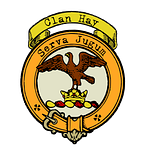Welcome back to "A Clan A Day Podcast," brought to you by bagtownclans.com. I'm your host, Colin MacDonald, and today we are exploring the fascinating history of Clan Matheson—a Highland clan with deep roots in Scotland's rugged northwest. From the shores of Lochalsh in Wester Ross, the Mathesons have been connected to significant events in Scottish history, their story echoing across the centuries with a mix of triumph, tragedy, and tenacity.
The name Matheson, or MacMathain in Gaelic, translates to "son of the bear," evoking strength and valor. It’s essential not to confuse this proud Highland name with the Lowland Matthewson, which simply means "son of Matthew." The Mathesons established themselves as a dominant force in Wester Ross, with early records placing them at the heart of some of Scotland's most pivotal moments. The earliest recorded chief, Kenneth MacMathan, served as the constable of the strategic Eilean Donan Castle. His name appears in both Norse chronicles and Scottish Chamberlain Rolls around 1263, when King Haakon IV of Norway launched his invasion of Scotland, culminating in the famous Battle of Largs.
Clan Matheson’s fortunes rose and fell with the tides of Scottish politics and clan warfare. In 1411, the Mathesons, under Chief Alastair, fought for Donald of Islay, Lord of the Isles, at the bloody Battle of Harlaw, one of the most significant clashes between Highlanders and Lowlanders. Alastair's leadership was formidable—he commanded 2,000 warriors, a testament to the clan’s strength during this period. But fortune is a fickle companion. In 1427, Alastair found himself caught up in the turbulent rule of King James I, who sought to bring Scotland’s more rebellious clans to heel. Alastair was summoned to a "parliament" in Inverness and, like many other powerful chiefs, was executed by the king, marking a significant blow to the clan’s influence.
Despite this setback, the Mathesons endured. Alastair's sons, John and Donald Bain, represent two distinct branches of the clan. John became the progenitor of the Mathesons of Lochalsh, while Donald Bain’s descendants, known as "Siol Wohan," settled in Sutherland. These two branches ensured the continuation of the Matheson legacy in different regions of Scotland. John, like his father, held the position of constable of Eilean Donan Castle. In 1539, defending the stronghold from an attack by the MacDonalds of Sleat, John was killed, marking the end of another chapter in the clan’s ongoing struggle for power.
Clan Matheson’s fortunes shifted again in the 17th century, when Dugald an Oir, a descendant of the original Lochalsh line, became the progenitor of the Mathesons of Attadale and Lochalsh. His descendants, particularly Sir Alexander Matheson, helped restore the clan’s standing. Sir Alexander, born in 1805, bought back the Lochalsh estate in 1851 and was later created Baronet of Lochalsh in 1882. His stewardship marked the revival of the clan’s lands and fortunes.
But perhaps the most famous Matheson in modern history is Sir James Matheson of the Shiness branch, a man whose story exemplifies the global reach of the Scottish diaspora. Sir James, through his involvement with Jardine, Matheson & Co., amassed a fortune in the Far East. He used his wealth to purchase the Isle of Lewis in 1844, and his generosity toward the island’s inhabitants during a time of famine earned him widespread respect. He was created Baronet of Lewis in recognition of his efforts.
Throughout the centuries, Clan Matheson’s influence stretched far beyond Scotland. Descendants of the Lochalsh and Sutherland branches can be found today in countries as far-flung as Australia, Canada, the U.S., and New Zealand. In fact, some Mathesons even found themselves ennobled in Norway, where they had traveled as mercenaries in the early 17th century.
The Mathesons are also remembered for their participation in Scottish feuds and battles, most notably against their traditional rivals, the MacLeods. One dramatic story tells of how a young Matheson chief, after fleeing from a usurping stepfather, later returned to Lochalsh, set the family castle ablaze, and reclaimed his rightful inheritance—though not without a dash of Highland cunning, as his mother secretly smuggled her husband out of the burning castle under her arisaid.
As with many Highland clans, the rise of the MacKenzies saw the Mathesons lose much of their original territory. Yet, the clan continued to play a significant role in the region, with Mathesons serving as loyal tenants and military leaders under the MacKenzies.
In modern times, the Matheson legacy lives on through prominent individuals like Sir Kenneth James Matheson, 8th Baronet of Lochalsh, who remains the clan’s current chief. The family’s connection to their ancient lands, including estates like Bennetsfield and Achany, reflects their enduring presence in the Highlands.
Today, the Clan Matheson Society works to preserve the history and heritage of this resilient family. From their ancient motto, "Dail Acha 'n Da Thearnaidh" (Field of the Two Pillars), to their enduring legacy of leadership, the Mathesons have left an indelible mark on Scotland’s cultural landscape.
Thank you for joining us on this journey into the history of Clan Matheson. We hope you’ve enjoyed this glimpse into one of Scotland’s great Highland families. Be sure to tune in tomorrow for another episode of "A Clan A Day Podcast." I'm your host, Colin MacDonald, and as always, Go n-éirí an bóthar leat.













Share this post